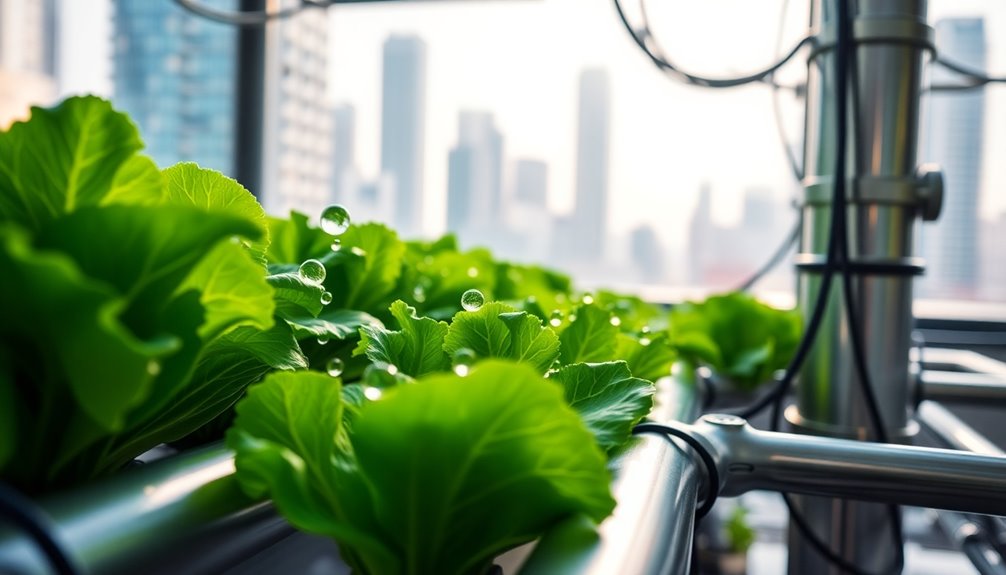Regenerative farming embraces practices that restore soil health and promote biodiversity. You'll minimize soil disturbance with no-till methods and maintain soil cover through living plants. Keeping living roots in the ground year-round boosts nutrient cycling and crop yields. By integrating livestock, you enhance soil fertility and foster natural pest control. These principles not only help combat climate change but also create a resilient ecosystem. Want to learn how to get involved and implement these practices effectively?
Key Takeaways
- Regenerative farming minimizes soil disturbance through low or no tillage, enhancing soil health and resilience.
- Maintaining year-round living roots improves nutrient cycling and supports soil biodiversity.
- Diverse cropping systems increase yields, reduce disease incidence, and promote ecosystem benefits.
- Integrating livestock in a managed way enhances soil fertility and natural pest control.
- Community engagement and education empower sustainable practices, strengthening local food systems.
Understanding Regenerative Agriculture

When you immerse yourself in regenerative agriculture, you'll discover it's all about restoring soil health and boosting ecosystem importance.
Through regenerative agriculture practices, you can enhance biodiversity and soil resilience, creating a thriving ecosystem. These practices focus on minimizing soil disturbance and maintaining living roots, which greatly contribute to carbon sequestration.
Enhancing biodiversity and soil resilience through regenerative agriculture fosters thriving ecosystems and supports carbon sequestration.
As healthy soils act as carbon sinks, they help mitigate climate change while improving water quality and increasing crop yields.
You'll also appreciate how these methods promote ecosystem services, benefiting not just your farm but the surrounding environment too.
Core Principles of Regenerative Farming
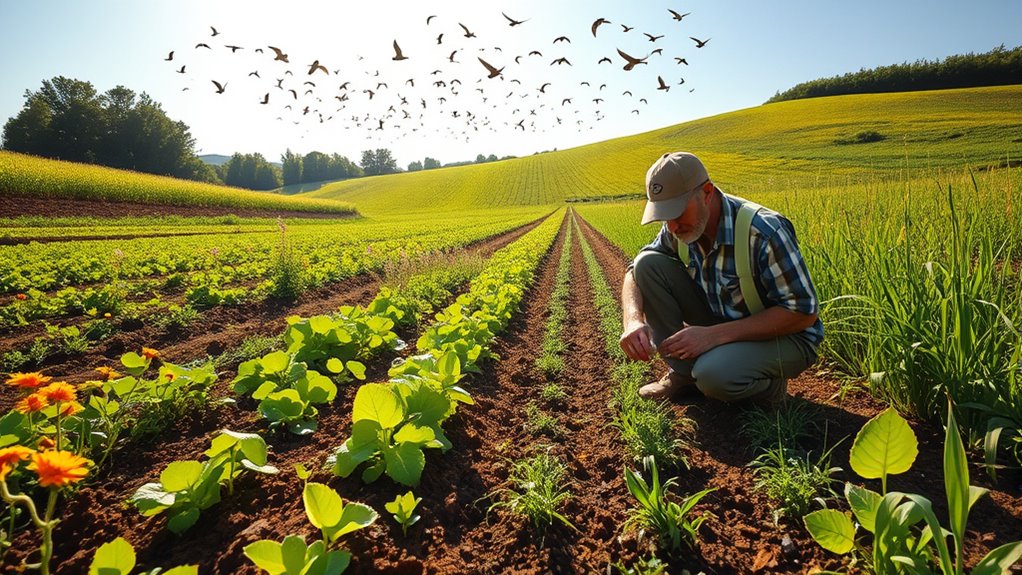
Regenerative farming thrives on a set of core principles that guide your practices toward sustainability and resilience.
Embracing these principles helps you enhance soil health and overall ecosystem vitality:
- Minimize soil disturbance through low or no tillage to preserve soil structure.
- Maintain soil cover with living plants or residues to protect against erosion.
- Keep living roots in the soil year-round to support nutrient cycling and feed soil organisms.
- Grow a diverse range of crops to promote biodiversity and increase ecosystem robustness.
- Integrate grazing livestock in a managed way to enhance soil fertility and biodiversity.
Ecological Benefits of Regenerative Practices
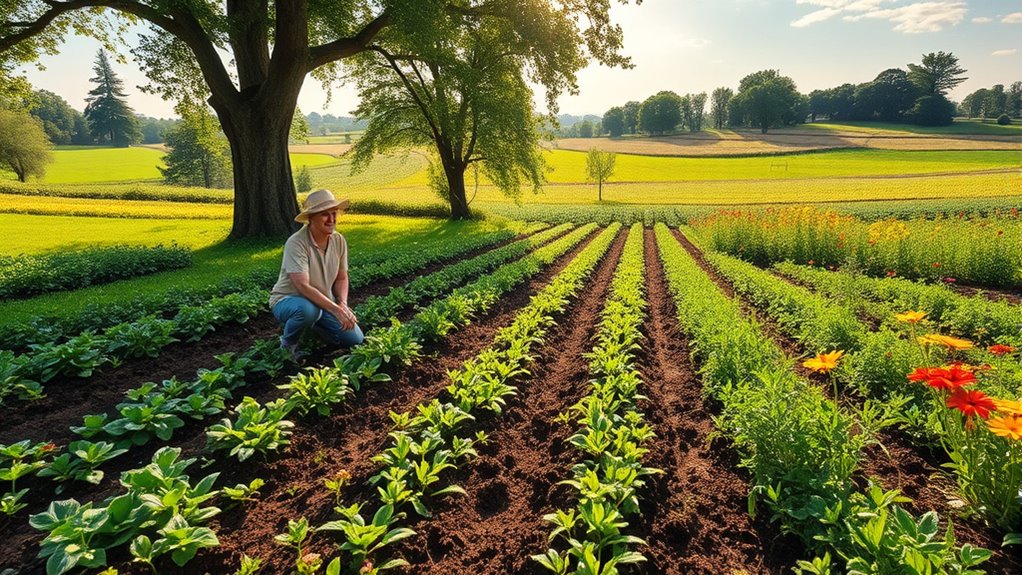
By adopting regenerative practices, you can release numerous ecological benefits that not only enhance soil health but also boost crop productivity. Regenerative farming methods markedly improve soil health and fertility, leading to healthier crops and up to a 20% yield increase. You'll also see enhanced biodiversity, with a 73% reduction in disease incidence among diverse crops. Practices like cover cropping and reduced tillage improve water resources, increasing soil's water-holding capacity and resilience against drought. Additionally, healthy soils act as carbon sinks, sequestering up to 2.6 billion metric tons of carbon dioxide annually.
| Benefit | Impact |
|---|---|
| Healthy Soils | Improves crop health and yields |
| Biodiversity | Reduces disease incidence |
| Water Resources | Enhances water retention |
| Soil Carbon Sequestration | Mitigates climate change |
| Microbial Diversity | Supports nutrient cycling and decomposition |
Economic Advantages of Sustainable Agriculture
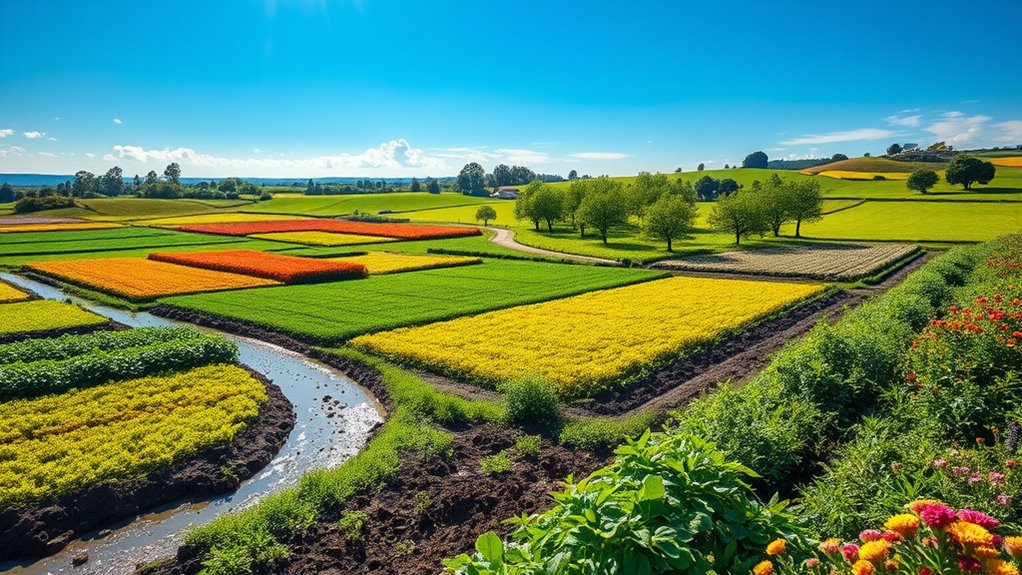
When you adopt regenerative agriculture, you could see significant cost savings by cutting back on synthetic fertilizers and pesticides.
This approach not only boosts your profit margins but also opens up diverse revenue streams, strengthening your local economy.
With healthier soil, you'll likely enjoy better crop yields and higher market value for your produce.
Cost Savings for Farmers
Farmers can greatly boost their bottom line through the cost savings associated with sustainable agriculture practices. By adopting regenerative techniques, you can:
- Reduce reliance on costly chemical inputs, potentially cutting costs by up to 30%.
- Improve soil health, which leads to higher crop yields and more marketable produce.
- Implement diverse cropping systems that enhance financial security and reduce risks.
- Utilize efficient water management to lower irrigation costs and improve resource management.
- Strengthen community relationships, increasing demand for your products in local markets.
These strategies not only contribute to immediate financial savings but also pave the way for long-term profitability and sustainability in your farming operations.
Diversified Revenue Streams
Adopting regenerative farming practices not only leads to immediate cost savings but also opens the door to diversified revenue streams.
By growing a diverse crop of fruits, vegetables, and livestock, you reduce your dependency on single commodity markets, enhancing your financial resilience. You'll likely benefit from direct-to-consumer sales, which typically offer higher profit margins than traditional wholesale markets.
Plus, integrating agroecological practices can help you create value-added products like organic jams or artisanal cheeses, further boosting your income potential. Participating in local food systems and community-supported agriculture (CSA) programs can provide you with a steady income while fostering strong relationships with consumers.
Ultimately, regenerative agriculture improves soil health, leading to better yields and lower long-term expenses.
Strengthened Local Economies
As regenerative agriculture flourishes, local economies reap significant benefits that extend beyond just the farm gate.
You'll notice that:
- Diversifying revenue streams enhances financial security for farmers.
- Lower operational costs arise from reduced reliance on chemicals and antibiotics.
- Local food systems keep money circulating within community economies.
- Increased demand for local food production creates job opportunities in rural areas.
- Higher-quality produce often commands premium prices, benefiting both farmers and consumers.
These elements work together to strengthen the local economy, ensuring that more resources flow back into your community.
Social Equity and Inclusion in Agriculture
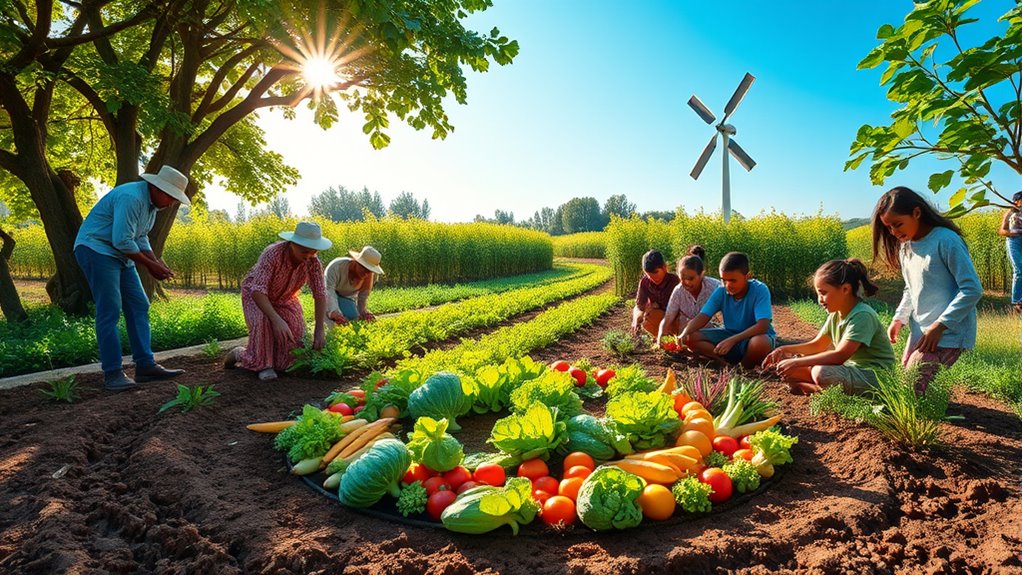
While the agricultural sector has long been marked by systemic discrimination, regenerative farming offers a pathway to foster social equity and inclusion.
By recognizing the value of Indigenous agricultural practices, you can help create a more equitable landscape for marginalized farmers. Advocating for equitable access to resources and opportunities guarantees that all voices are heard, particularly for farmers of color and women.
Community engagement plays a crucial role in this process, enabling support networks that empower underrepresented growers. Together, you can promote inclusive policies and financial incentives that encourage diverse farming communities to adopt sustainable farming methods.
This transformation not only enhances social equity in agriculture but also strengthens local food systems for everyone involved.
Addressing Climate Change Through Regenerative Methods
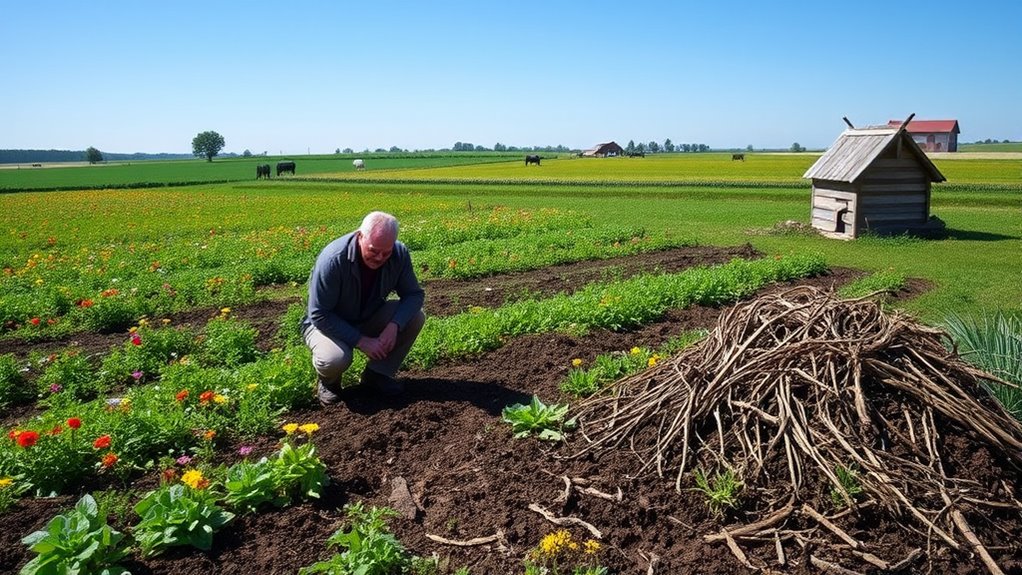
Regenerative farming not only champions social equity but also plays a pivotal role in tackling climate change. By enhancing soil health, you're helping soils act as carbon sinks, considerably reducing greenhouse gas emissions.
Consider these benefits:
- Healthy soils sequester over 2 billion metric tons of carbon dioxide yearly.
- Improved soil structure boosts water retention, enhancing resilience against droughts.
- Regenerative practices can cut greenhouse gas emissions by 30% in agriculture.
- Diverse crop rotations and reduced tillage reverse soil degradation.
- These practices help mitigate climate change effects, fostering a sustainable future.
Additionally, utilizing eco-friendly practices such as cover cropping and minimal tillage contributes to healthier soils and a more resilient agricultural system.
Transitioning to regenerative agriculture isn't just about farming; it's a commitment to the planet's health and your community's well-being.
Embrace these methods and make a difference.
Techniques for Implementing Regenerative Agriculture
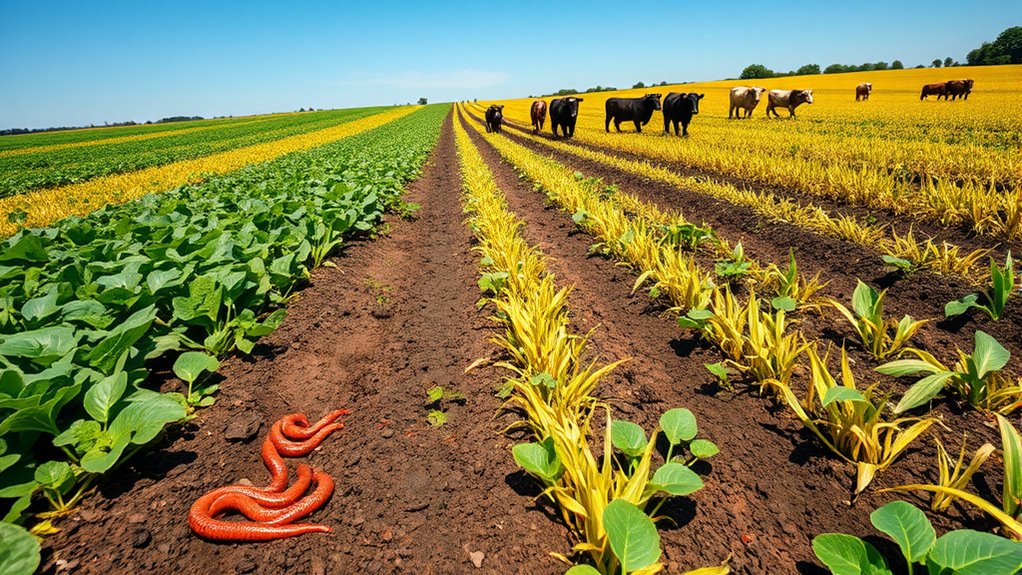
Five key techniques can help you implement regenerative agriculture effectively.
First, practice cover cropping to protect your soil, reduce erosion, and enhance nutrient cycling by keeping living roots in the ground year-round.
Practice cover cropping to safeguard soil health, curb erosion, and boost nutrient cycling by maintaining living roots year-round.
Second, minimize soil disturbance through no-till farming, preserving soil structure and boosting microbial activity, which improves soil health.
Third, embrace crop diversity using rotational cropping and companion planting to build resilience against pests and diseases while supporting beneficial organisms.
Fourth, adopt managed grazing techniques, like holistic grazing, to promote nutrient cycling and organic matter deposition through controlled livestock grazing.
Finally, regularly assess soil health and adjust your practices based on soil quality to enhance nutrient cycling and sustain productivity over time.
The Role of Biodiversity in Soil Health
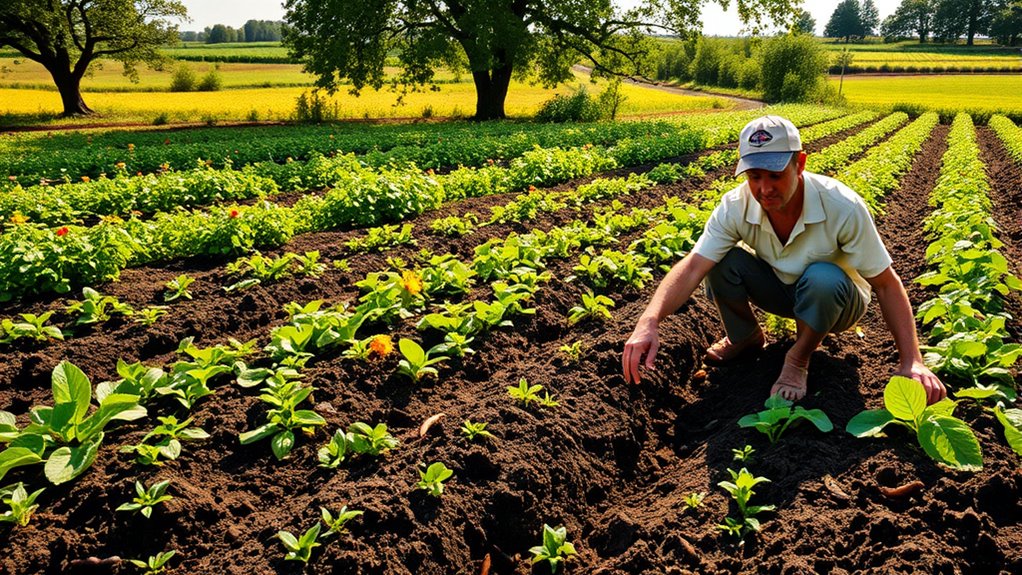
Biodiversity plays an essential role in enhancing ecosystem resilience and nutrient cycling efficiency in your soil.
When you incorporate a variety of plants and animals, you not only create a balanced environment but also improve the health and fertility of your land.
This diverse approach can considerably boost your crop productivity and reduce pest pressures, leading to a more sustainable farming system.
Enhancing Ecosystem Resilience
When you embrace diverse plant and animal species on your farm, you strengthen the ecosystem's resilience, which is essential for maintaining soil health.
By fostering biodiversity, you enhance natural pest control and reduce reliance on chemicals, promoting overall farm health.
Consider these benefits:
- Diverse crops can lead to a 73% reduction in disease prevalence.
- Integrating animal species like cattle and chickens improves nutrient cycling.
- A healthy ecosystem enhances soil structure and fertility.
- Biodiversity reduces stress on crops, supporting better yields.
- Resilient ecosystems adapt more effectively to climate variability.
- Additionally, solar-powered irrigation systems can help optimize water usage and improve crop yields.
Through regenerative agriculture practices, you build a thriving ecosystem that supports both your soil health and agricultural productivity.
Nutrient Cycling Efficiency
To achieve ideal nutrient cycling efficiency on your farm, embracing a variety of plant and animal species is key.
Biodiversity enhances soil health by fostering diverse soil organisms that break down organic matter and recycle nutrients effectively. You'll notice that diverse plant species enrich the soil, supporting different root structures and exudates that boost microbial activity.
Integrating animals like cattle, sheep, and chickens promotes natural pest control, nutrient cycling, and aeration, all of which enhance soil fertility.
Studies show that increasing crop diversity can cut disease incidence by up to 73%, supporting overall ecosystem diversity.
Healthy ecosystems improve soil structure, facilitating better water retention and ensuring nutrient availability during dry spells.
This interconnected approach strengthens nutrient cycling efficiency on your farm.
Community Engagement and Support for Regenerative Practices

Engaging the community in regenerative farming practices not only strengthens local food systems but also builds essential connections between farmers and consumers.
By fostering these relationships, you enhance access to healthier food options and support local economies.
- Educational initiatives empower you and your neighbors to adopt sustainable practices.
- Workshops offer hands-on experiences that encourage knowledge sharing among participants.
- Collaborative networks among growers lead to resource exchange and improved soil health.
- Local governments can provide financial assistance through incentive programs.
- Engaging marginalized communities promotes inclusivity and equity within agriculture.
Together, these efforts create a resilient agricultural landscape that benefits everyone involved while ensuring sustainable practices for future generations.
How to Get Involved in Regenerative Agriculture
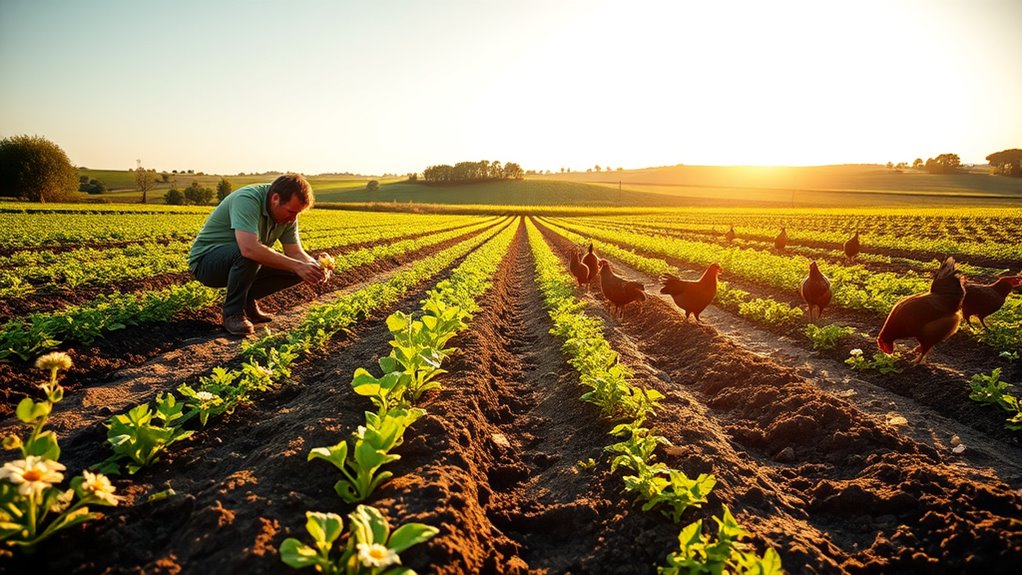
You can get involved in regenerative agriculture by connecting with local farmers and community-supported agriculture programs to support sustainable practices.
Consider implementing sustainable gardening techniques at home, like composting and crop rotation, to enhance your own soil health.
Local Farming Partnerships
As you explore ways to support regenerative agriculture, local farming partnerships offer a fantastic opportunity to connect with sustainable practices right in your community.
Here are some ways to get involved:
- Visit local farmers' markets to engage with regenerative farmers directly.
- Join a community-supported agriculture (CSA) program for fresh, seasonal produce.
- Collaborate with local agricultural organizations for educational resources and workshops.
- Volunteer on nearby regenerative farms to gain hands-on experience in sustainable farming techniques.
- Advocate for local policies that support regenerative agriculture initiatives.
Sustainable Gardening Practices
While embracing sustainable gardening practices, you can greatly contribute to regenerative agriculture in your own backyard.
Start by implementing composting techniques to recycle organic waste, which improves soil health and enriches your garden. Choose a diverse mix of crops to enhance soil resilience against pests and diseases.
Practicing minimal soil disturbance through no-till or low-till methods preserves soil structure and promotes microbial life, resulting in healthier soils. Additionally, use cover crops during the off-season to protect and nourish your soil, preventing erosion and enhancing nutrient cycling.
Frequently Asked Questions
What Are the Four Principles of Regenerative Agriculture?
The four principles of regenerative agriculture focus on enhancing soil health and ecosystem resilience.
First, you minimize soil disturbance to protect microbial life.
Next, you maintain soil cover with crops or residues to prevent erosion.
Then, you keep living roots in the ground year-round to support nutrient cycling.
Finally, you promote biodiversity by cultivating diverse crops and integrating livestock, which strengthens the overall ecosystem and helps your farm thrive in challenging conditions.
What Is the Sustainability of Regenerative Agriculture?
You might wonder if regenerative agriculture really is sustainable. The truth is, it greatly enhances soil health, promotes biodiversity, and reduces reliance on chemicals, making it a viable long-term solution.
By focusing on practices like minimal soil disturbance and crop diversity, you boost ecosystem resilience and improve water retention. Plus, it can save you money on inputs while providing healthier produce.
What Is the Regenerative Approach to Sustainability?
The regenerative approach to sustainability focuses on restoring and enhancing the health of ecosystems.
You'll prioritize practices that minimize soil disturbance, promote biodiversity, and support local food systems. This means adopting methods like crop rotation and no-till farming, which help maintain soil integrity and support microbial life.
What Are the Three Pillars of Regenerative Agriculture?
The three pillars of regenerative agriculture are soil health, biodiversity, and ecosystem resilience.
You enhance soil health by using practices like minimal tillage and cover cropping, fostering a thriving microbial community.
By integrating diverse crops and livestock, you promote biodiversity, which aids natural pest control.
Finally, adopting holistic management improves ecosystem resilience, allowing your farm to adapt to climate change and extreme weather, ensuring sustainability for future generations while producing healthy food.
Conclusion
As you step into the vibrant world of regenerative farming, picture lush fields teeming with life, where soil breathes and plants thrive in harmony. Embracing these principles not only nurtures the earth but also fosters a community bound by shared values and dreams of sustainability. Together, you can cultivate a future where nature flourishes, economies thrive, and everyone shares in the bounty. So, roll up your sleeves and join this essential movement—your hands can help heal the planet.





